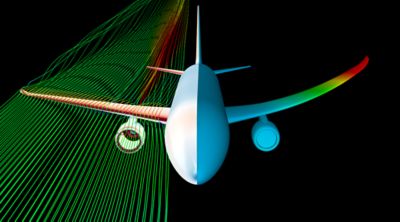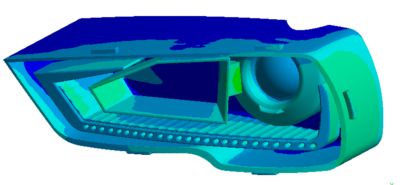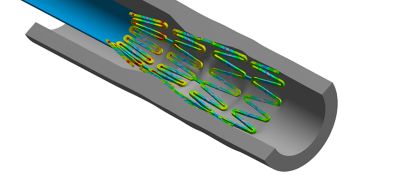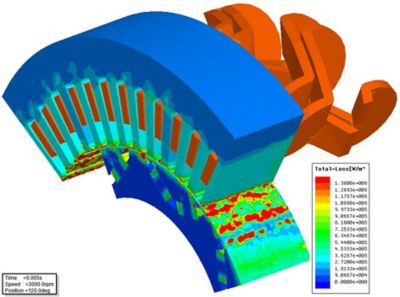什么是多物理场?
在现实生活中,物理现象不会单独发生,比如,流体力、结构力、热和电磁力会不断相互作用。在这些物理域相互作用的地方,会出现传热、变形和质量传递等现象。
多物理场方法,就是通过计算机仿真来分析物理力之间的复杂相互作用。通过将单独的物理场求解器整合到统一的计算框架中,多物理场工作流程可帮助工程师根据物理场在现实世界中的情况,一次性对整个系统的行为进行准确建模。
多物理场模型弥合了单物理场分析的不足之处。

使用多物理场工作流程进行分析的部分应用示例。
多物理场示例
当多个物理场相互作用时(如流体和结构,或结构与电磁),它们被称为“耦合”。我们周围时刻发生着这类现象,比如从轻触手机屏幕到驾驶汽车走过崎岖的道路,都涉及多个物理场的相互作用。多物理场耦合的常见示例包括:
流固耦合(FSI):
飞机安全:对气流(流体力学)如何影响起落架的变形和减震(结构力学)进行建模
热-光学耦合:
抬头显示器(HUD):对室外温度(热效应)如何影响车辆中投影图像的清晰度(光学)进行建模
结构-声学耦合:
道路噪声:对轮胎-表面的摩擦(结构力学)如何引起车辆中的听觉反馈(声学)进行建模
电磁-热耦合:
发电:对电机的能量场(电磁学)如何产生热量(热动力学)进行建模,以优化换热器和风扇
需要多物理场分析的工程问题可通过不同程度的耦合来求解。
如果物理问题涉及物理场的弱耦合,例如流体力产生了结构应力,但没有使结构显著变形,我们可以通过单向耦合分析来解决此问题。
如果存在强耦合,例如,如果结构具有高变形并影响流动,则我们需要双向耦合解决方案。
多物理场应用
在各个行业中,工程师都依靠多物理场解决方案来在设计流程早期发现问题,做出明智的优化决策,并确保最终产品的安全和性能。企业必须能够准确预测复杂产品在现实环境(包含多种类型的耦合物理场相互作用)中的行为方式。
航空航天:流固耦合分析,以确定飞机机翼的最佳重量、形状和结构

汽车:对车灯中的热膨胀和变形进行仿真,以预测光学性能

医疗:对人体组织和医疗设备结构(如植入物和支架)之间的相互作用进行建模

工业:通过磁、结构和声学分析识别振动源,减少电机的磨损

多物理场仿真
由于成本、时间或安全等约束条件,对多个物理域之间同时发生的复杂相互作用进行实验研究不是一件易事,而通过多物理场仿真,可以对这些相互作用进行建模。通过跨工程学科传递和转换数据信息,借助仿真,人们可以更深入地了解产品性能。
计算机运算能力的最新发展、求解器速度和性能的提升以及工作流程构建方法的改进,加速了从单物理场仿真到综合多物理场仿真的转变。这种演变使工程师能够更好地预测其设计在现实世界中的运行情况。
多物理场仿真的优势
逼真的建模:准确捕获多个物理域同时相互作用的真实场景
系统级分析:深入了解物理耦合如何影响整体系统性能
时间效率:同时分析整个系统,而不是仅对单独物理域进行分析
多物理场仿真的挑战
数据一致性:不同的物理域具有不同的时间尺度、空间尺度和网格分辨率
用户专业知识:解释多物理场仿真需要跨学科专家的知识
计算成本:多物理场仿真的处理强度需要大量的资源和时间
多物理场分析工具
通常,单个求解器侧重于特定的物理领域,如结构力学、流体力学或电磁学。但有些求解器包含独立的多物理场模型。例如,除了流体力学分析之外,Ansys Fluent®流体仿真软件还可以对声学、运动、固体传热和热应力进行建模。当模型共享几何结构、网格和设置时,具有多物理场功能的单个求解器对于耦合分析非常有用。
但随着产品复杂性的增加,单一物理场仿真可能不再满足需求。
这正是协同仿真的用武之地。通过连接专用求解器,可以更精确地捕获不同物理现象之间的复杂相互作用。例如,Ansys System Coupling™物理求解器连接软件等工具可在统一的界面中集成所有主要求解器。这意味着,工程师可以在单个统一的工程环境中轻松创建高保真度的多物理场模型。
单求解器多物理场:在一个求解器中对一组特定的耦合物理场方程执行跨域分析。其提供紧密耦合相互作用的简单设置。
系统耦合多物理场:在一个计算框架中,在不同专用求解器之间协调和交换数据。在需要协调独立求解器来捕获物理模型之间相互作用的复杂情况中,其可提供更灵活的建模。
多物理场的未来
一些产品发展趋势推动了对多物理场建模更广泛应用的需求,包括芯片和3D集成电路(3D-IC)中的可持续性和更高的功率密度要求。随着企业不断创新,努力提高功率和减少浪费,多物理场分析将为其提供全面了解设计中物理现象之间相互作用所需的整体洞察能力。
相关资源
现在就开始行动吧!
如果您面临工程方面的挑战,我们的团队将随时为您提供帮助。我们拥有丰富的经验并秉持创新承诺,期待与您联系。让我们携手合作,将您的工程挑战转化为价值增长和成功的机遇。欢迎立即联系我们进行交流。